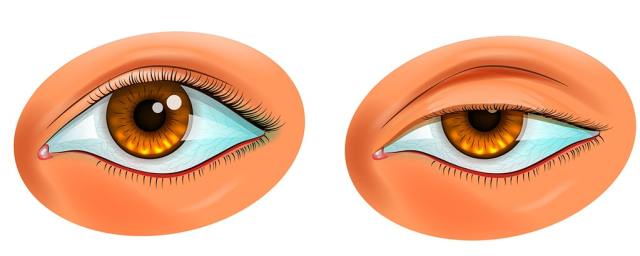Drooping Eyelids Causes and Treatment in Türkiye
Drooping eyelids, also known as ptosis, can occur due to various reasons such as trauma, aging, or different medical conditions.
What is ptosis?
This condition is called “unilateral ptosis” when it affects one eye and “bilateral ptosis” when it affects both eyes.
Ptosis can occur intermittently and may be present even at birth, known as “congenital ptosis,” or it can develop later in life, referred to as “acquired ptosis.”
Depending on the severity, drooping upper eyelids can obstruct or significantly reduce vision.
The problem is typically resolved naturally in most cases or through medical intervention.
Who can be affected by ptosis?
There are various potential causes of ptosis, ranging from natural reasons to more serious conditions. A doctor can help identify the underlying cause of the problem.
Anyone can experience ptosis, and there are no significant differences in its prevalence between genders or races.
However, it is more common in older individuals due to natural aging, where the levator muscle responsible for lifting the eyelid may stretch with age, leading to drooping.

It is worth noting that people of all ages can be affected by this condition. Some children are born with ptosis, although this is rare.
The cause of ptosis is sometimes unknown, but in other cases, it may be due to trauma or a neurological issue.
Congenital ptosis in children:
The most common cause of “congenital ptosis” is improper growth of the levator muscle. Children with ptosis may also have strabismus, commonly known as “lazy eye,” which can lead to delayed or limited vision.

What are the risk factors for ptosis?
Certain medical conditions may increase the risk of developing ptosis:
Medical conditions:
If both eyelids are drooping simultaneously, it could be a sign of an underlying medical condition, especially if it affects both eyelids.
If only one eyelid droops, it may be due to nerve damage or a temporary abscess. In some cases, it can be attributed to LASIK surgery or routine cataract surgery when muscle or tendon stretching occurs.
Serious conditions:
In some cases, ptosis may be caused by more serious conditions such as stroke, brain tumor, nerve or muscle cancer.
Neurological disorders affecting the nerves or muscles of the eye, such as myasthenia gravis, can also lead to ptosis.
What are the symptoms of ptosis?
The main symptom of ptosis is the drooping of one or both upper eyelids. In some cases, it may affect vision. However, many people may hardly notice or experience only occasional drooping.
Some individuals with ptosis may experience excessively dry or teary eyes, causing significant discomfort and fatigue around the eyes.
In severe cases of drooping eyelids, some people may need to tilt their heads backward to maintain clear vision during conversations or regular activities.
A doctor will examine the drooping eyelids to rule out any associated medical conditions. This is especially important if the patient experiences frequent headaches or other problems since the onset of ptosis.
How is ptosis diagnosed?
A doctor will likely perform a physical examination and inquire about the patient’s medical history. Once the patient provides information on the frequency and duration of their eyelid drooping, the doctor may conduct some tests to identify the cause.
A “Tensilon test” is often used to diagnose issues like ptosis. The doctor injects a drug called Tensilon, commonly known as “edrophonium,” into a vein. The patient will be asked to look upward and open their eyes or perform a few squats and stands.
The doctor observes if the Tensilon test improves muscle strength. This helps determine whether the condition is called “myasthenia gravis,” which causes ptosis.
How is Ptosis (Drooping Eyelid) Treated?
The treatment of ptosis depends on the specific cause and severity of the condition.
If the ptosis is due to aging or present from birth (congenital), the doctor may recommend not doing anything as it usually does not pose a health risk. However, cosmetic surgery can be an option if you wish to reduce the drooping.
If your doctor finds that ptosis is caused by an underlying health condition, addressing that condition may treat the ptosis and prevent further drooping.
If the drooping eyelid obstructs vision, medical intervention becomes necessary, and your doctor may recommend surgery.
Another non-surgical option is “ptosis crutches” or “ptosis props.” These are glasses with a small attachment designed to hold up the drooping eyelid. This treatment is more effective when the ptosis is temporary. Glasses may also be recommended if you are not a good candidate for surgery.
Surgery:
Your doctor may recommend eyelid lift surgery (blepharoplasty) to treat ptosis. This surgery tightens the levator muscle, which lifts the eyelid to the desired position. In the case of children with ptosis, doctors sometimes recommend surgery to prevent the development of lazy eye (amblyopia).
However, there are risks associated with surgery, including dry eyes, scratched cornea, and hematoma (blood collection). Hematoma is a pooling of blood.
Another alternative is the “frontalis suspension procedure,” where the forehead muscles are used to lift the eyelids.
Ptosis Props:
Ptosis props are non-surgical options that involve adding a small attachment to the patient’s eyeglass frames. This attachment prevents the drooping by holding the eyelid in place.
There are two types of ptosis props: Modified and Reinforced. Modified ptosis props are attached to one side of the frames, while reinforced ptosis props are attached to both sides.
These props can be added to almost any type of eyeglass frames, but they work best with metal frames. If you are interested in using a ptosis prop, consult an eye doctor or a specialized cosmetic surgeon who offers ptosis treatment.
Can Ptosis Be Prevented?
There is no way to prevent ptosis. Being aware of the symptoms and undergoing regular eye examinations can help in managing this condition.
If you notice that your child has a drooping eyelid, take them to the doctor immediately for evaluation and treatment.
As ptosis can affect vision, it should be taken seriously. Prompt medical attention can potentially prevent it from worsening.
Long-Term Outlook for People with Ptosis:
Ptosis typically does not cause health issues. However, if both eyelids obstruct vision, you should avoid driving until the condition is treated.
The long-term outlook depends on the cause of ptosis. In most cases, it is simply a cosmetic issue.
However, as ptosis can sometimes be a sign of a more serious condition, it is essential to consult a doctor.
How can I book a ptosis treatment in Türkiye?

- Free medical support on the phone: You will have a dedicated representative for your health condition who is always ready to answer your questions.
- Free consultation with a specialist doctor: Your medical representative will consult with a number of doctors and hospitals to find the best possible treatments.
- Free travel visa arrangement: We will contact the embassy in your country to assist you in obtaining a visa to visit Türkiye.
- Free itinerary planning: We will create a schedule for your medical trip to Türkiye.
- Free translation of documents and reports: We will translate medical documents and reports into Turkish on your behalf.
- Free support and monitoring: We will monitor the stages of treatment and be by your side every step of the way.
- Free instant translation: We will be with you during the treatment stages to provide translation between you and the medical team.
- Free accommodation and transportation coordination: We will book accommodation for you and your companions in Türkiye, along with transportation services.
Contact REHABTÜRK doctors for more information about the procedure and to evaluate your medical condition.

